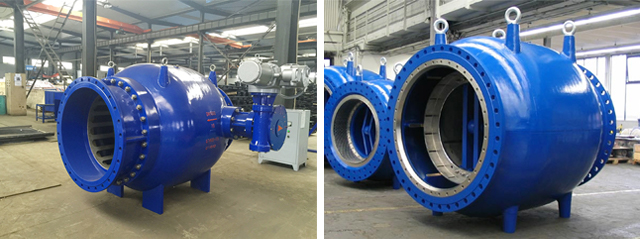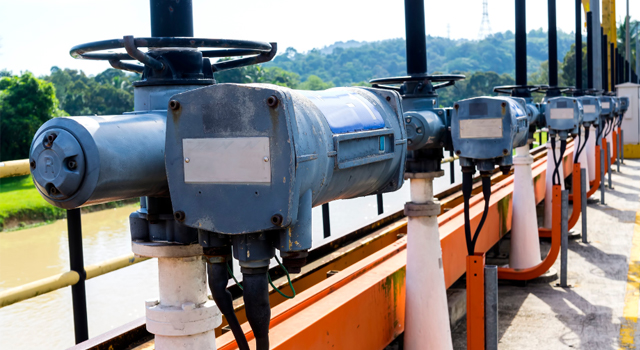- Gate valve
-
- DN1000 Extension stem double flange soft seal gate valveDIN F4 resilient seated gate valveDN450-1200 Resilient Seated Gate ValveDIN F5 resilient seated gate valveSocket connection soft seal gate valveUnderground cap soft seal gate valveBS5163 rising stem soft seal gate valveHard seal gate valveAPI slab Gate ValveStainless steel flange gate valveWafer knife gate valvePneumatic gate valveSoft seal gate valveExtension stem gate valveUL/FM fire protection groove ends gate valveRising stem forged steel gate valvecarbon steel gate valveStainless steel threaded gate valveDIN soft seal gate valveANSI soft sealing gate valve 200PSICast iron gate valveBS resilient seated gate valve
- Butterfly valve
-
- DN900 pneumatic triple eccentric hard seal butterfly valveD643H Triple Eccentric Butterfly ValveD343H Hard seal butterfly valveMulti standard EPDM seated butterfly valveSingle flange butterfly valveDN2000 Double eccentric butterfly valveFlange butterfly valveLug butterfly valveWafer butterfly valve with handleWorm gear operated butterfly valveWafer lined fluorine butterfly valveStainless steel wafer butterfly valveStainless steel flanged butterfly valveThree eccentric flange butterfly valvePneumatic flanged butterfly valvePneumatic wafer butterfly valveTriple eccentric butterfly valve wafer typeWafer butterfly valve ULC approvedInflatable seat butterfly valveHigh performance butterfly valveGrooved end butterfly valveElectric soft seal butterfly valveFlange fluorine lined butterfly valveHandle aluminum butterfly valveWorm Gear Aluminum Butterfly ValveFull PTFE lined butterfly valve wafer typeOne stem no-pin wafer butterfly valveMulti standard aluminum stem butterfly valveStainless Steel wafer Butterfly ValveAluminium handle operated lug butterfly valveLever Operated Flange Butterfly ValveButterfly valve stemButterfly valve discButterfly valve seat
- Ball valve
-
- DN1400 top-mounted eccentric semi-ball valveFlanged three-way ball valveFully welded ball valveNatural gas ball valveHigh platform flange ball valve1 PC ball valveFixed ball valvePTFE seat flanged ball valveMetal seat ball valveAPI 6D ball valve3 Piece ball valveFull Bore 3 way ball valve L-Port3 Way T-Port ball valve2PC Ball valve female thread stainless steel
- Globe Valve
-
- API Carbon Steel Globe ValveBellows Globe ValveStainless steel flange globe valveStainless steel thread S type globe valveStainless steel thread B type globe valveCast Steel Globe ValvePiston Globe ValveWCB Carbon Steel Globe Check Valveelectric motorized control stainless steel SS316 globe valveBrass Globe ValveCryogenic Globe valveHT200 Globe ValveThreaded Stainless Steel Globe ValveGG25 Globe ValveANSI API Cast Steel And Stainless Steel Globe valve
- Check valve
-
- Rubber seal check valveDN800 Slow closing check valveDN800 Rubber Disc Check ValveButterfly Buffering Check Valvecheck valve with counter weightSilent Check ValveWCB Swing check valveSwing Check ValveSingle Chip Check Valve H74WStainless Steel Wafer Check ValveSwing Start Check ValveFoot check valveAPI Swing Check ValveDIN Flange check valveSingle plate check valveLifting Check ValveBottom ValveHammer Diminish Noises Check ValveWafer Check ValveWafer dual plate check valve
- Control valve
-
- Static Balancing ValveCage Guided Sleeve Globe Control ValveDN1000 Piston Flow Regulating ValveDN1600 Electric Actuator Flow Regulating ValvePneumatic Flanged Butterfly ValvePneumatic Wafer Butterfly ValveAngle Seat ValvePneumatic gate valveElectric three-way control valveElectric sleeve control valve
- Water Meter
-
- Vertical Type Water MetersStainless steel threaded water meterPiston water meterPlastic water meterMore flow rotor dry water meterspiral vane flange water meterCI wotlman water meter with pulse outputLXCLG(R) Vertical removable element woltman cold (hot) water meterSingle flow rotor dry water meterPrepaid Token Water MeterElectromagnetic flowmeterRotary Piston Liquid Sealed Water MeterRotary Piston Liquid Sealed Water Meter
- Air valve
-
- Double ball exhaust valveDoubleair Air Valve SaudiDoubleair Air Valve Southeast AsiaDoubleair Air Valve South AmericaDouble Air ValveThreaded Air ValveSingle Air ValveTriple Functions Air ValveAutomatic Air Release ValveAutomatic release valveAutomatic exhaust valveComposite Exhaust Air ValveBrass exhaust valveDouble Ball Air Valve
- Pipe Repair & Coupling
-
- Flexible Multi-Function Pipe Coupling ZFJ-SSS Semi-Circle Pipe Repair Clamp SJW-HDuctile Iron Band Repair ClampStainless Steel Band Repair ClampDouble-Section Pipe Repair CouplingFolding Type Pipe RepairSingle-Section Multi-Function Pipe Coupling MF-SGear-Ring Type Multi-Function Pipe Coupling GR-SZBW Damping Corrugated Hose
- Dismantling Joint
-
- VSSJAFC(CC2F) Detachable Flange Transmission JointVSSJA-2(B2F) Double Flange Limited Expansion JointVSSJA-1(BF) Single Flange Limited Expansion JointVSSJA(AF) Flange Loose Expansion JointJGD-B Threaded Rubber JointZBW Damping Corrugated HoseKXT-S Flexible Dual-Spherical Rubber JointKXT Rubber Soft JointFlange Adaptor
Precautions for selection of regulating valves
Selection of valve type:
2. Determine the valve type, and its leakage to meet the process requirements.
3. Determine the valve type, its working differential pressure should be less than the valve's allowable differential pressure, such as not, it is necessary to consider from a special point of view or choose another valve.
4. The temperature of the medium in the valve's operating temperature range, the ambient temperature, meets the requirements.
5. According to the medium of the unclean situation consider the valve's anti-blocking problem.
6. According to the chemical properties of the medium to consider the corrosion resistance of the valve.
7. According to the differential pressure and containing complex media, consider the valve erosion and wear resistance.
8. The comprehensive economic effect of the performance and price ratio. Need to consider three issues:
a. Simple structure (the simpler the higher reliability), easy maintenance, spare parts have a source;
b. Service life;
c. Price.
9. Preferred order.
1. The simplest is pneumatic thin-film type, followed by piston type, and finally electric type.
2. The main advantage of electric actuator is the convenience of driving source (power supply), but the price is high, reliability, waterproof, and explosion-proof is not as good as pneumatic actuator, so the pneumatic type should be preferred.
3. The old electric actuator is bulky, we have electronic compact and highly reliable electric actuator to provide (price is correspondingly high).
4. The old ZMA, ZMB thin-film actuators can be eliminated, by the multi-spring lightweight actuators instead (improved performance, weight, and height down about 30%).
5. Piston actuator varieties of specifications more, the old, big and bulky recommendations are no longer selected, and the choice of light new structure.
Material selection:
1. Regulating valve body pressure rating, use of temperature and corrosion resistance should be no less than the requirements of the process connection pipeline, and should give priority to the use of manufacturing plant stereotypes.
2. Water vapour or wet gas containing more water and flammable and explosive media, should not be selected cast iron valve.
3. Ambient temperature below -20 ℃ (especially in the north), not suitable for cast iron valves.
4. For vapour corrosion, erosion is more serious medium temperature and pressure difference constitutes a right-angle coordinates, its temperature is 300 ℃, the pressure difference is 1.5MPa two points outside the line of the region, the throttle sealing surface should be selected wear-resistant materials, such as cobalt-based alloys or surface surfacing Stryker alloys, etc..
5. For strong corrosive media, the selection of corrosion-resistant alloys must be based on the type of media, concentration, temperature, pressure, select the appropriate corrosion-resistant materials.
6. The valve body and throttle parts are treated separately, the valve body wall throttling speed is small and allows a certain degree of corrosion, the corrosion rate can be lmm / year or so; throttle parts are subject to high-speed scouring, corrosion will be bowed [up the leakage increase, the corrosion rate should be less than 0.1mm / year.
7. On the lining material (rubber, plastic) the choice of the working medium temperature, pressure, concentration must meet the use of the material range, and consider the valve action on its physical and mechanical damage (such as shear damage).
8. Vacuum valve is not suitable for selection of the valve body lined with rubber, plastic structure.
9. Water treatment system of the two cut-off valve is not suitable for rubber-lined materials.
10. Typical media typical corrosion-resistant alloy material selection:
a. Sulfuric acid: 316L, Hastelloy, alloy 20.
b. Nitric acid: aluminium, C4 steel, C6 steel.
c. Hydrochloric acid: Hastelloy B.
d. Hydrofluoric acid: Monel.
e. Acetic acid, formic acid: 316L, Hastelloy.
f. Phosphoric acid: Inconel, Hastelloy.
g. Urea: 316L.
h. Caustic soda: Monel.
i. Chlorine: Hastelloy C.
j. Seawater: Inconel, 316L.
(11) So far, the most versatile corrosion-resistant material is fluorine, known as the "king of corrosion resistance". Therefore, should be the first choice of all PTFE corrosion-resistant valves, as a last resort (such as temperature > 180 ℃, PN> 1.6) before the choice of alloy.
Selection of flow characteristics:
Provided below is a preliminary selection, detailed selection see special information:
1. Select logarithmic characteristics when S>0.6.
2. Small opening work, unbalance force changes when the logarithmic characteristic is selected.
3. Requirements of the regulated parameters reflect the speed of fast selection of linear, slow selection of logarithmic.
4. Pressure regulation system can be selected linear characteristics.
5. Level adjustment system can be selected linear characteristics.
Flow direction selection:
1. In the throttle port, the medium to the spool open direction flow for flow open, to close the direction of flow for flow closed.
2. The choice of flow direction is mainly a single seal class control valve, there are single seat valve class, angle valve class, single seal sleeve valve three categories. Base it for the specified flow direction (such as double seat valve, V ball) and arbitrary flow (such as O ball).
3. When dg>15, usually selected flow open, when dg≤15 small diameter valves, especially high-pressure valves can be selected flow closed to improve life.
4. For two-position switching valve can be selected flow closed.
5. If the flow-closed type valve produces oscillation, change over, flow-open type can be eliminated.
The choice of packing:
1. Regulating valve commonly used is fluorine "V" shaped packing and graphite "O" shaped packing.
2. PTFE packing friction is small, but poor temperature resistance, short life; graphite packing friction, but good temperature resistance, long life; high temperature and with the locator valve is recommended to choose graphite packing.
3. If the PTFE packing is often changed, graphite packing can be considered.
Selection of accessories:
1. The accessories of regulating valve mainly include: positioner, converter, relay, booster valve, holding valve, pressure reducing valve, filter, oil mist, travel switch, position transmitter, solenoid valve, handwheel mechanism.
2. Accessories play a supplementary function and ensure the operation of the valve. Increase if necessary, do not increase if unnecessary. Adding accessories unnecessarily increases the price and reduces reliability.
3. The main function of the positioner is to improve the output force and speed of action, do not need these functions, may not bring, not with the positioner is good.
4. For fast response system, don't want the valve to move fast, optional converter.
5. Strict explosion-proof occasions, optional: electrical converter + pneumatic positioner.
6. Solenoid valve should choose reliable products to prevent to it when the action is not action.
7. Important occasions are not recommended to use the handwheel mechanism to prevent human error.









